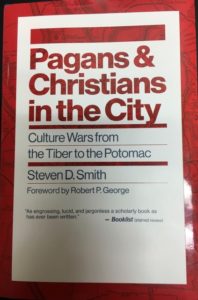A review of Pagans & Christians in the City/Culture Wars from the Tiber to the Potomac, by Stephen D. Smith
Stephen D. Smith is the author of several works concerning  secularism and religious freedom, some of them from a Constitutional and legal perspective, as befits a law professor, as he is. In this book, he convincingly advances the theme that we have not so much moved to post-Christian sterile materialism, as to a resurgence of paganism. Smith contends that the pagan world never really left us. Over history it has been tamped down, so to speak, or relegated to the margins as Christianity ascended, but it never really went away. He considers the chief elements of this latent paganism to be as follows.
secularism and religious freedom, some of them from a Constitutional and legal perspective, as befits a law professor, as he is. In this book, he convincingly advances the theme that we have not so much moved to post-Christian sterile materialism, as to a resurgence of paganism. Smith contends that the pagan world never really left us. Over history it has been tamped down, so to speak, or relegated to the margins as Christianity ascended, but it never really went away. He considers the chief elements of this latent paganism to be as follows.
First, a sense of immanence. This is more a “feel,” than a hard fact. It is the sense of enchantment to the world that, Smith contends, still obtains despite the materialist secularism now prevalent. That immanence stands in opposition to transcendence. Some clarification is in order. Christianity holds there to be a transcendence to reality, which means God and His host in heaven, but His presence also running in and through physical reality; meaning that He is present with us. It does not mean, however, that divinity in some way infuses or animates physical reality. To the contrary, a signal feature to the rise of Christianity as against paganism is that physical creation stands apart from its Creator. Smith uses “immanent” to mean embodied within physical reality. This can be confusing, at first, because God is said to be immanent and Smith uses immanence in opposition to transcendence. Smith apparently means to assert that pagan gods are immanent like God is immanent, but that they are only immanent; that is, not transcendent from a supernatural realm as with God.
Second, a repudiation of immortality. Belief in an afterlife is rejected, by pagans, as it is among many post-Christian neo-pagans. Smith points out that this does not necessarily translate to a sense of meaninglessness, however. In fact, many pagans argue that life has more meaning because of the absence of an afterlife. In the present age, many secularists have considered the question, and, like their pagan forbears, argue that life has more meaning, not less, as a result of there being no afterlife as Christianity proposes.
Third, a longing for earthy richness that paganism is thought to provide, in place of moral austerity that Christianity is thought to stand for. To his credit, Smith gives this felt sense in people the attention it deserves, despite its subjective nature. He cites to the sense of longing people have had, all through the Christian era, for a return to earthy pleasures uninhibited by shame and guilt, especially with regard to sexual license. There is a sense that paganism was “a merry dance,” lost to us now inside the constraints of Christianity. It makes sense, therefore, that the distinguishing feature of the post-Christian zeitgeist is greater sexual license. The removal of inhibitions against sex outside marriage is the definitive turn from a Christian to a post-Christian, pagan view of the world.
An overarching theme to Smith’s observations is that paganism survives and becomes again ascendant because it relies on feelings – subjective longing for freedom, rather than critical analysis of truth. From the Enlightenment period forward there is a repeated series of falsehoods about Christianity that (citing Rodney Stark in Stark’s Bearing False Witness) “are so mutually reinforcing and deeply embedded in our common culture that it seems impossible for them not to be true.” The result is that misunderstanding about the effects of Christianity feeds the subjective impression that its moral demands can be safely ignored.
Christianity (or Judaism, or even Islam) is the harder version of reality to accept and embrace. Smith observes, from our subjective feelings rather than objective truth, that
“it might be plausibly argued that paganism is the natural condition of humanity. From the moment of our birth until the hour of our death, after all, we see and hear and feel and act within this world. This is the world that we know directly and personally – the world we can be sure of. Conversely, we are consigned to rely on inference or intimation or faith to discern anything beyond this world. So we will naturally tend to find meaning and sublimity within this world – the one we know and inhabit. Paganism in this existential sense may draw sustenance from ancient precedent, but even without that support, it will naturally arise on its own. And Christianity could not reasonably expect to eradicate that natural orientation.”
Again, this is not to say Christianity is untrue, but Smith is explaining here why paganism has been latent in the Christian era, ready to arise whenever obstacles are removed.
Smith captures where we have come from and where we are going. There are insights on every page, too many to do justice in a short review. But I recommend this book, even if you only read one book to try to understand the place of religion in the modern age.
